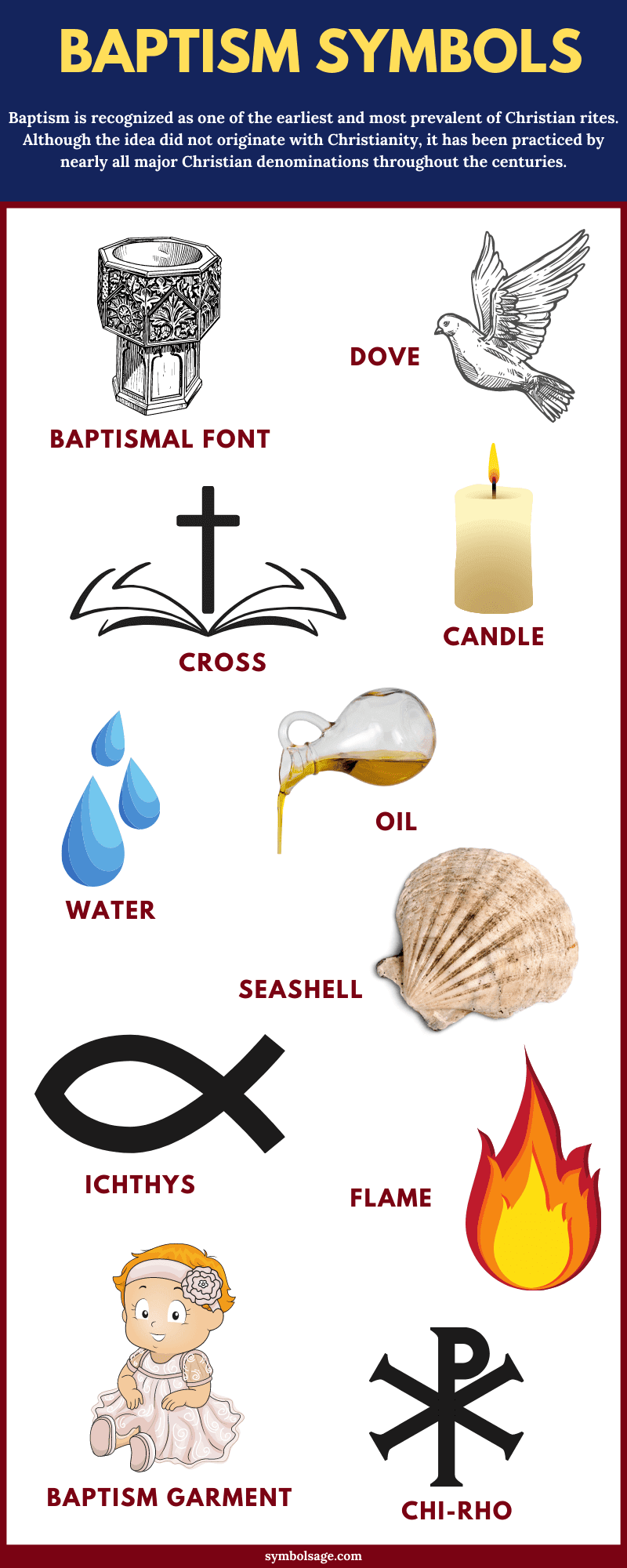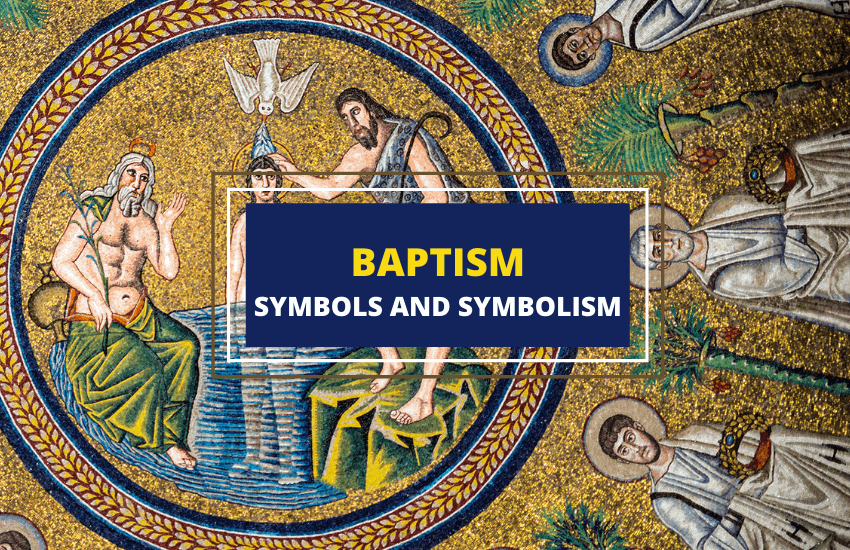
Table of Contents
Baptism is recognized as one of the earliest and most prevalent Christian rites. Although the idea did not originate with Christianity, it has been practiced by nearly all major Christian denominations throughout the centuries.
Within Christianity, there are several varying views on its meaning and practice. There are also several symbols that represent baptism.
What Does Baptism Symbolize?
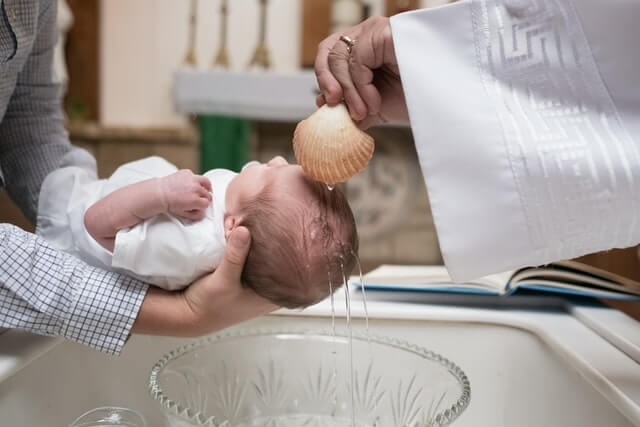
Over the centuries, various denominations of Christians have understood the meaning of baptism differently.
However, there are a few points of shared meaning on which most Christians agree. These points often serve as the basis for ecumenical partnerships.
1. Death and Resurrection
One of the most common phrases uttered during a baptismal rite is something similar to, “buried with Christ in baptism, raised to walk in new life”.
The symbolism of baptism is often seen as a ritual cleansing or washing of sin. We will see that some groups see this as part of the meaning.
Yet, at a deeper level baptism identifies the initiation with the death burial, and resurrection of Jesus Christ for the forgiveness of sins.
2. Trinitarian Theology
According to the instructions of Jesus, baptismal ceremonies commonly include the phrase, “In the name of the Father, the Son, and the Holy Spirit”.
This inclusion is understood as a tacit agreement with historical orthodox Trinitarian belief.
3. Membership
Baptism is also understood as a rite by which a person becomes a member of the body of Christ, or in other words the church.
This means the person has joined the community of Christians both in their local congregation and as a part of the broader Christian fellowship.
Symbols of Baptism
There are several key symbols used to represent baptism. Many of these play an important role during the ritual of baptism.
1. Baptism Water
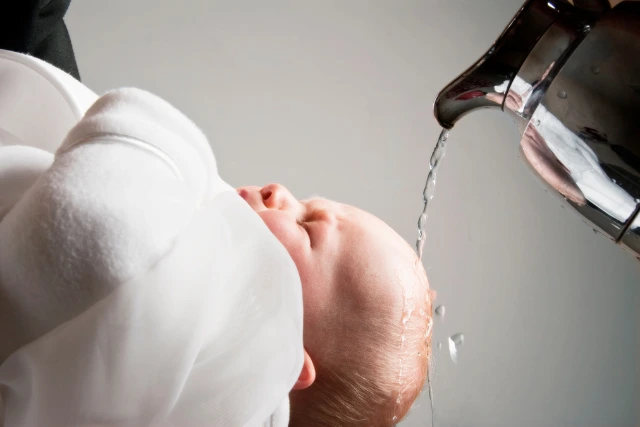
Baptism water is one of the principal symbols of baptism. It is one of the sacraments of the Church and is depicted as one of the most essential elements to ordain a new member of a Christian Church.
Many believe that unless a person is born of water and spirit, they cannot enter the Kingdom of God. Baptism water represents one’s sins being washed away. Therefore, when a person is baptized, they become pure.
Baptizing someone with water can involve partial or full submersion of the person underwater to symbolize the stages of Jesus’ journey – life, death, and resurrection.
When a person is submerged, their body identifies with Christ’s death. When they arise from the baptizing water, they identify with Christ’s resurrection.
Being submerged in baptizing water means that one is no longer alive to the power of sin.
2. The Cross
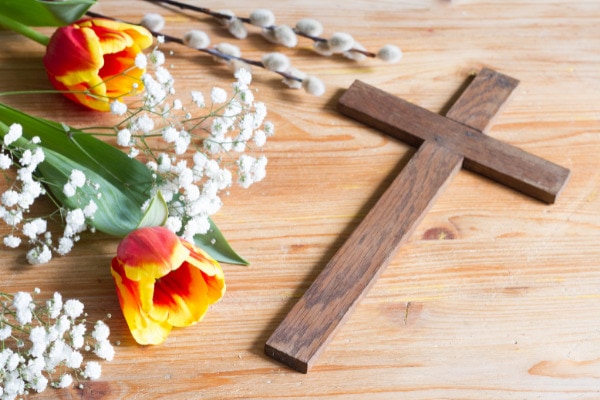
The cross is an ever-present symbol used during the baptism. Making the sign of the cross over the person being baptized, especially children, is done to invoke God’s protection and allow the body to enter the body of the Christian Church.
Drawing the sign of the cross on the forehead of a person symbolizes that the soul is marked as the Lord’s possession and that no other force may claim the power of that soul.
When Christians make the movement to draw a cross, they renew the baptismal promises, which is the rejection of Satan and all ungodly forces.
The cross is, of course, a symbol of Christ’s crucifixion upon which he was crucified and sacrificed to clear the sins of humankind. Over the centuries, the cross became a fundamental symbol of Christianity.
3. Baptismal Garment

The baptismal garment is a type of attire that is worn by those who are baptized. The garment reflects that the newly baptized will become a new person, entirely cleared of sins and ready to accept God.
Those being baptized wear the baptismal garment either at the start of the ritual or after emerging from the water.
The symbolism of the garment is that the person is now clothed with Christ and has been born again.
4. Baptismal Font
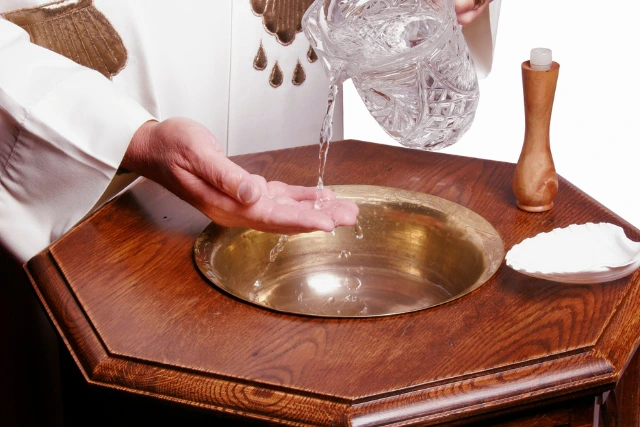
The Baptismal Font is a church element used for baptism and may have different designs depending on the church.
These fonts can be up to 1.5 meters, and they can be either very eclectic or minimalist, small fonts without much ornamentation.
Baptismal fonts can be large pools in which a person can be fully submerged, or they can be smaller fonts that the priests use to sprinkle or pour baptismal water over the person’s head.
Some are eight-sided, symbolizing the eight days of baptism, or three-sided, symbolizing the Holy Trinity – the Father, the Son, and the Holy Spirit.
In the past, baptismal fonts were placed in a separate room away from the rest of the church, but today these fonts are often placed at the entrance to the church or within a prominent location for easy access.
5. Oil

The baptismal oil is an ancient symbol of the Holy Spirit. It is used to represent the Holy Spirit, not only during baptisms but also at other religious gatherings.
When an infant is baptized, it is anointed with oil symbolizing the joining of the Holy Spirit and the person together.
The baptismal oil strengthens the fate of the anointed to turn away from evil and temptation and sin. A priest or a bishop blesses the oil and anoints the person with the sacred oil calling upon the salvation of Christ.
It is common to use pure olive oil in Eastern Orthodoxy, and the priests bless it three times before putting it in the baptismal font.
6. Candle
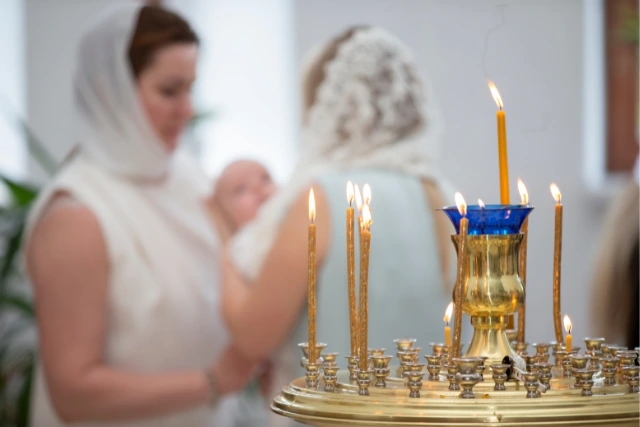
The baptism candle or the baptism light is one of the most important symbols of baptism because it represents Jesus Christ, the light of the world, and his victory over death.
The candle is also a symbol of life and light without which nothing would exist on Earth. It’s a symbol of creation and vitality and represents the perseverance of the Christian faith.
7. Dove

In Christianity, the dove is a symbol of the Holy Spirit. In the Bible, it’s mentioned that when Jesus was being baptized by John, the Holy Spirit descended on Jesus in the form of a dove.
From this, the dove became a symbol of the Holy Spirit and all who are baptized receives this spirit through the baptism.
8. Flame

The flame is commonly associated with the Holy Spirit coming down from the heavens as tongues of fire during the Pentecost.
While water symbolizes the purity and cleansing of the spirit, fire symbolizes the Holy Spirit’s transformation into the person that is baptized.
9. Seashell
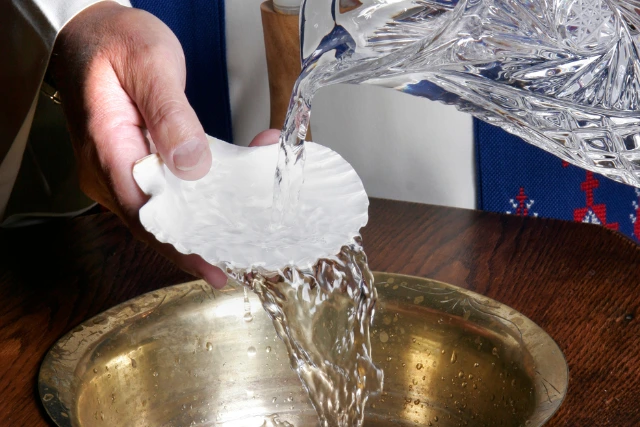
Seashells were associated with baptisms because they were sometimes used to pour water over the person being baptized.
The story goes that St. James used a seashell to baptize his converts in Spain, as he didn’t have anything else on hand to use as a tool.
Seashells are also symbols of the Virgin Mary. In some depictions, seashells are depicted as containing three drops of water indicating the Holy Trinity.
10. Chi-rho
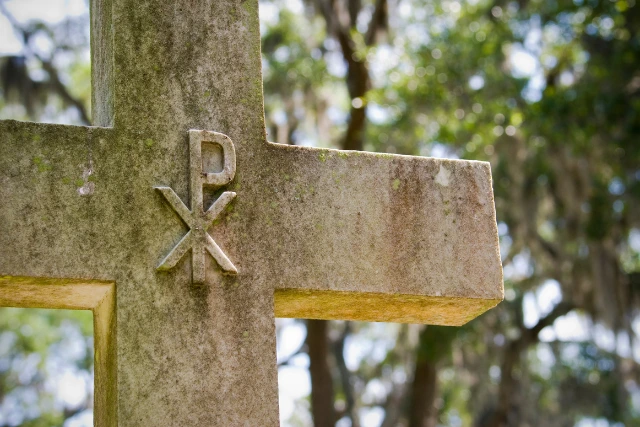
The chi-rho is one of the oldest Christian pictograms and is often written on items that are associated with and used during the baptism.
In Greek, the letter chi is associated with the English letters CH, and Rho is the equivalent of the letter R. When put together, the letters CHR are the first two letters of the Greek word for Christ. This monogram is used to represent Christ.
Chi-rho is written on baptismal elements used during baptisms to symbolize that the person is baptized in the name of Jesus.
11. Fish

The fish is among the oldest Christian symbols, partly stemming from the view that Jesus was a ‘fisher of men’. It symbolizes the holy miracle of Jesus multiplying bread and a fish to feed the faithful.
Fish also symbolizes the first meal that Christ had after the resurrection. The fish symbol is also known as the Ichthys and was used during the times of the Roman persecution of Christians as a way to identify fellow Christians.
It is commonly believed that a fish represents the baptized person.
In contrast, a collection of fish represents the entire Christian community gathered in a net that protects them. The net is the Christian church, keeping the group together.
The fish symbolizes the new life that a person is given when they receive baptism. When put in order of three fishes, they represent and symbolize the Holy Trinity.
Origins of Baptism
The origin of Christian baptism comes from the account of Jesus’ life found in the synoptic gospels (Matthew, Mark, Luke). These writings give an account of Jesus being baptized by John the Baptist in the Jordan river. The Gospel of John also alludes to this event.
The fact that Jesus was baptized by his older cousin is evidence that baptism did not originate with Christianity. The extent to which baptism was practiced among 1st-century Hebrews is unclear. It is apparent that many were coming to participate. Baptism was not unique to Jesus and his followers.
The origin of baptism as a Christian rite is also found in the Gospel accounts of Jesus’ life and teaching. The Gospel of John tells of Jesus baptizing those in the crowds who followed him around Judea.
In his final instructions to his followers, Jesus is recorded as saying, “Go therefore and make disciples of all nations, baptizing them in the name of the Father and of the Son and of the Holy Spirit…” (Matthew 28:19)
Early History of Baptism
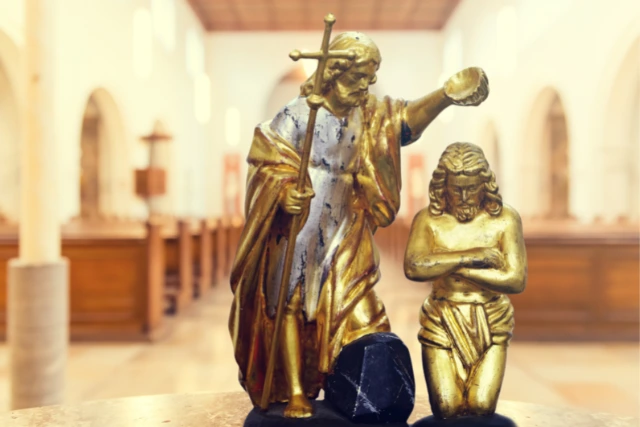
The earliest accounts of Jesus’ followers show that baptism was a part of the first conversions to the nascent religion prior even to its recognition as anything more than a small sect of Judaism (Acts 2:41).
An ancient writing known as the Didache (60-80 CE), agreed by most scholars to be the earliest Christian writing still in existence other than the Bible, gives instructions for how to baptize new converts.
Modes of Baptism
There are three different modes of baptism practiced by Christians.
- Affusion is practiced by pouring water over the head of the initiate.
- Aspersion is the practice of sprinkling water on the head, common in infant baptism.
- Immersion is the practice of submerging the participant into water. Sometimes immersion is distinguished from submersion when immersion is practiced by wading partially into the water and then dipping one’s head thus not completely submerging the entire body.
Meaning of Baptism in Different Christian Denominations
There is a wide range of meanings among denominations today. Here is a summary of the beliefs of some of the more prominent groups.
1. Roman Catholic
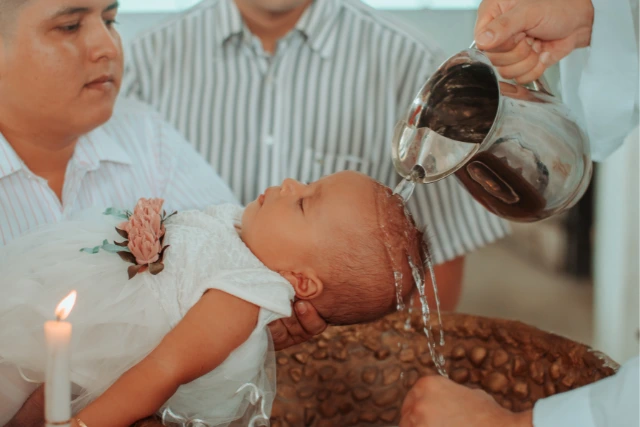
In Roman Catholicism, baptism is one of the sacraments of the church and enables the person to receive the other sacraments.
It is necessary for salvation, and in most cases must be performed by a priest or deacon. The necessity of baptism for salvation led to the practice of infant baptism from as early as the 2nd century.
The doctrine of original sin, especially as taught by St. Augustine in the 5th century, further spurred the practice since every person was born sinful. Baptism is necessary to have this original sin cleansed.
2. Eastern Orthodox
In the Eastern tradition baptism is an ordinance of the church and the initiating act of salvation for the remission of sin. It results in a supernatural change in the initiate.
The mode of baptism is immersion, and they do practice infant baptism. The Protestant Reformation of the 16th Century opened the door for many new beliefs concerning the rite of baptism.
3. Lutheran

Though Martin Luther began the Protestant Reformation, it was not over the practice of baptism, and his theology never strayed far from the Catholic understanding.
Today, Lutherans recognize baptism by immersion, sprinkling, and pouring. It is understood to be the way of entrance into the church community and by it, one receives forgiveness of sin resulting in salvation. They do practice infant baptism.
4. Presbyterian
Presbyterian churches recognize all four modes of baptism and practice infant baptism. It is understood to be a sacrament of the church and a means of grace.
By it, one is sealed with the promise of regeneration and the remission of sin. It is also a way of admission into the church. It is a visible sign of an inward change.
5. Anglican and Methodist
Because Methodism grew out of the Anglican Church, they still hold much the same beliefs concerning the ritual. It is understood to be an external confirmation of internal regeneration.
Baptism cleanses from sin, gives new life through rebirth, and brings one into the membership of the church.
These groups all practice pouring and immersion. Methodists emphasize the internal change that has taken place, and also practice sprinkling along with the other modes.
6. Baptist
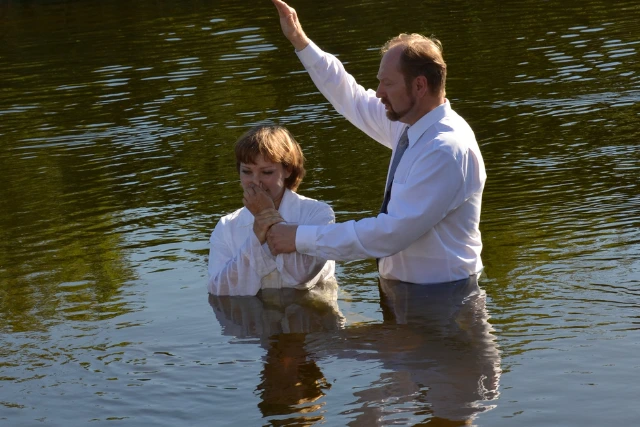
The baptist tradition can be traced to one of the earliest groups coming out of the Reformation, the Anabaptists, so named because they rejected the baptism of the Catholic church.
For baptists, the rite is understood as a ceremonial expression of one’s salvation already accomplished and a public testimony of faith in Christ. They practice submersion only according to the definition of the Greek word translated to baptism.
They reject infant baptism. Most community churches and non-denominational churches follow similar beliefs and practices.
In Brief
Baptism is one of the longest-standing and most consistently practiced rites in Christianity.
This has led to many differences in the symbolism and meaning among denominations, yet there are still points of common belief around which Christians around the world unite.
Similar Articles:
15 Bible Symbols and Their Meanings
15 Powerful Symbols of Life (And What They Mean)
Popular Christian Symbols – History, Meaning and Importance
Types of Christianity – A Brief Overview
